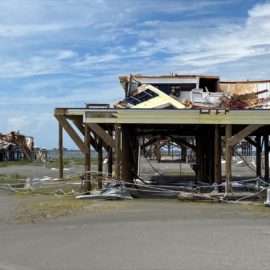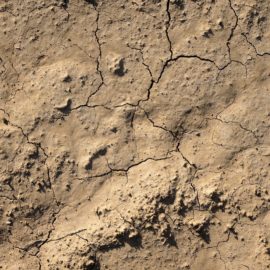
Our levees held for Ida but Grand Isle was washed with damaging water. Is that right? Should they have better protections? Louisiana reviews storm policies.
Hurricane Ida’s devastating storm surge has prompted Louisiana officials to reconsider whether Grand Isle‘s 13½-foot-high dunes and the Lafitte area’s 7-foot levees and floodwalls are adequate for the survival of both communities and – if not – whether the towns are worth the cost of greater protection. “You have heard from the Corps and others about the sand dunes on Grand Isle being sacrificial,” Chairman Chip Kline told the Coastal Protection and Restoration Authority on Wednesday. “I think it’s safe to say that if the sand dune, the burrito levee, had not been there, the devastation would have been much worse on Grand Isle.” But going forward will require “hard conversations” that must weigh potentially dramatic costs for increased storm surge protection for both locations against the value of keeping both areas populated, Kline said.
nola.com

Coastal Protection and Restoration Authority
Grand Isle’s dunes are all that protects it from storm surge. They keep getting rebuilt. Lafitte is in the same boat.
For Grand Isle, the strategy to date has been to pump sand from the Gulf of Mexico to keep dunes elevated atop burrito levees, which are fabric-covered tubes of sand that serve as a base for the dunes. After each hurricane washes away the exterior sand, more is pumped in. But Ida’s surge almost wiped out the sand part of the dunes and shredded the burritos, washing sand inland to cover streets and yards across the island. Portions of the dune system suffered slightly less damage during hurricanes in 2020 and in past hurricanes, including Katrina in 2005. In the Lafitte area, the state and Corps agreed years ago that the number of residents and financial value of businesses were not enough to provide protection against storm surges from major hurricanes, the same 1 percent or “100-year” level provided by the West Bank and Vicinity levee system to the north. Ida overwhelmed Lafitte area’s 7-foot levees with surge levels at least that high and waves half again as high.
Both regions have asked for more protection. The state and the Corps of Engineers get these requests.
Grand Isle and Lafitte leaders have long begged for greater protection from storms. Notwithstanding the population – 1,450 in Grand Isle and an estimated 4,000 in Jean Lafitte, Barataria, Crown Point and lower Lafitte, – they stress that these areas serve as important buffers against hurricanes hammering more populated and developed parts of the New Orleans area. “If the federal government is going to make investments in Grand Isle and Lafitte, they’re going to need to make resilient investments, and those don’t look resilient to me,” Kline said of proposals to rebuild the same protection that was in place before Ida. On Thursday, Kline said the state and the Army Corps of Engineers are looking at a “more robust beach and dune template along the entire island,” possibly including “a hardened dune feature at strategic locations” to reduce breaching and scour during storms. The review includes revisiting the “design storm” on which the levee is based, which is now a surge event with a 2% chance of occurring in any year, a so-called 50-year storm. For the Lafitte communities, state officials are interested in reviewing levee protection from at least tidal flooding, with a review of higher levels of protection for hurricanes. In addition, the state wants to consider whether it’s feasible to elevate all structures and harden, or storm-proof, the drainage pumps, Kline said.
Terrebonne Parish is also asking for more.
Terrebonne Parish also received an expensive and unexpected wake-up call from Ida’s surge. The 98-mile-long Morganza-to-the-Gulf levee system surrounding Houma was designed to protect the region from surges moving north from of the Gulf of Mexico. It is not complete, with much of the system built to protect from only 12 feet of surge, the equivalent of a 50-year storm, largely because Congress has failed to pay its 75 percent share of the construction cost. But Ida delivered an unwelcome surprise, said Reggie Dupre, director of the Terrebonne Levee and Conservation District. The storm made landfall at Port Fourchon, east of the parish, which meant surge from the Gulf moved up the Barataria Basin instead of across the front of the Morganza system. The Category 4 storm’s counterclockwise winds then pushed water south into the supposedly protected area behind the levee system, with a tsunami-like effect on the Bubba Dove storm surge barge gate. A wall of water higher than the gate, 14 feet above sea level, damaged its electrical and hydraulic systems and knocked it 70 feet out of place. Dupre estimated the damage to be as much as $7 million, and damage to four other gates, plus the cost of removing storm debris from gate areas and atop earthen levees, will cost the system another $20 million or more.
There are other levee systems that held up in addition to ours.
The Larose to Golden Meadow levee system, already at the 1 percent or 100-year height, made it through Ida with no significant damage, Windell Curole, executive director of the South Lafourche Levee District, told the coastal authority. While 96 percent of the North Lafourche Levee District’s levees weren’t topped by Ida’s surge, the rest sustained significant damage, especially around Larose and Kraemer, said district executive director Duane Bourgeois. Some of the damage might have been averted by the long-delayed construction of the Upper Barataria hurricane levee system. The Corps has proposed completing that levee during the next few years, but the plan has not yet made it through the agency’s approval process. There is some good news involving levees and Ida’s surge. The West Bank and Vicinity levee system, completed to 100-year standards after Katrina, protected Algiers and the more populated parts of West Jefferson from any flood damage, said Nicholas Cali, regional director of the Southeast Louisiana Flood Protection Authority-West. “This storm was a true test of the system, and this is proof of concept. This is a return on investment,” he said, adding that $242 million in building value in Algiers and $1.2 billion in western Jefferson, and their 210,000 residents, suffered no surge damage.

(North Lafourche Levee District)
The levees in our area were upgraded and that helped us.
Heath Jones, emergency manager for the Corps’ New Orleans District office, told the coastal authority that the new and upgraded segments of the West Bank levees eliminated wave and surge topping much of the western half of the system, as well as along the Harvey and Algiers canals, now cut off from surge by the West Closure Complex. A recent project elevating the Mississippi River levee in St. Charles Parish also protected that part of the West Bank from overtopping. The same held true for the Lake Pontchartrain and Vicinity, or east bank, levee system, overseen by Southeast Louisiana Flood Protection Authority-East, said regional director Kelli Chandler. “It’s proof in the investment the Corps made,” she said. In all, Congress authorized $14 billion for the east and West Bank levee improvements after Katrina.

(Army Corps of Engineers)
St Bernard was also protected showing that this general area did well.
Jones said the east bank system likely protected St. Bernard Parish from topping by surge on its southwestern corner near Caernarvon. The new Lake Borgne Barrier wall likely blocked surge and waves from topping the Gulf Intracoastal Waterway and the western wall of the Industrial Canal in New Orleans, which would have flooded parts of the Lower 9th Ward and New Orleans East.
Levees, if properly done, work. Should all threatened areas get them?



